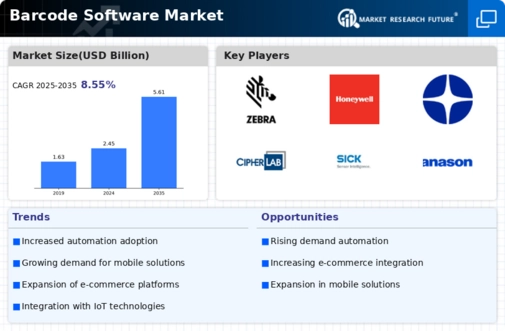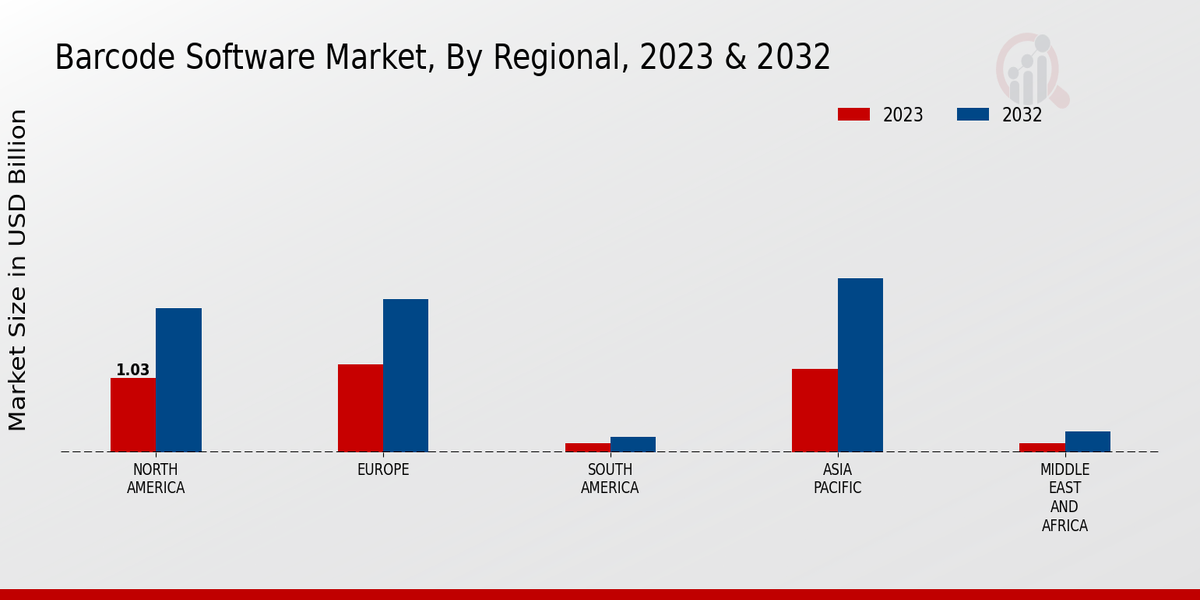Expansion of E-commerce
The rapid expansion of e-commerce significantly influences the Global Barcode Software Market Industry. With the increasing volume of online transactions and the necessity for efficient logistics, businesses are adopting barcode software to manage inventory and shipments effectively. This trend is particularly evident in the retail sector, where barcode systems facilitate real-time tracking of products from warehouse to customer. The e-commerce sector is expected to contribute substantially to the market growth, with projections indicating a rise to 5.61 USD Billion by 2035. This growth underscores the critical role of barcode technology in supporting the logistics of online retail.
Market Growth Projections
The Global Barcode Software Market Industry is projected to experience substantial growth over the coming years. With an estimated market value of 2.45 USD Billion in 2024, the industry is expected to expand significantly, reaching 5.61 USD Billion by 2035. This growth trajectory suggests a compound annual growth rate of 7.83 percent from 2025 to 2035. Such projections indicate a robust demand for barcode software solutions across various sectors, driven by the increasing need for automation, efficiency, and compliance in inventory management and tracking.
Rising Demand for Automation
The Global Barcode Software Market Industry experiences a notable surge in demand for automation across various sectors, including retail, logistics, and manufacturing. This trend is driven by the need for efficiency and accuracy in inventory management and tracking. Companies are increasingly adopting barcode solutions to streamline operations, reduce human error, and enhance productivity. For instance, the implementation of barcode systems in warehouses has been shown to decrease order processing time by up to 30 percent. As a result, the market is projected to reach 2.45 USD Billion in 2024, reflecting the growing reliance on automated solutions.
Integration with IoT Technologies
The integration of barcode software with Internet of Things (IoT) technologies is reshaping the Global Barcode Software Market Industry. This convergence enables real-time data collection and analysis, enhancing supply chain visibility and operational efficiency. For example, IoT-enabled barcode systems can provide insights into inventory levels, allowing businesses to optimize stock management. The potential for improved decision-making through data analytics is driving adoption across various industries. As organizations increasingly recognize the benefits of IoT integration, the market is likely to witness a compound annual growth rate of 7.83 percent from 2025 to 2035.
Regulatory Compliance and Traceability
Regulatory compliance and the need for traceability are pivotal drivers in the Global Barcode Software Market Industry. Industries such as pharmaceuticals and food and beverage are mandated to adhere to strict regulations regarding product tracking and safety. Barcode software facilitates compliance by providing accurate tracking of products throughout the supply chain. This capability not only ensures adherence to regulations but also enhances consumer trust. As regulatory frameworks continue to evolve, the demand for barcode solutions that support compliance is expected to grow, further propelling market expansion.
Technological Advancements in Barcode Solutions
Technological advancements in barcode solutions are significantly influencing the Global Barcode Software Market Industry. Innovations such as 2D barcodes and mobile scanning applications are enhancing the functionality and versatility of barcode systems. These advancements enable businesses to capture more data in a compact format, improving inventory management and customer engagement. For instance, the adoption of mobile barcode scanning applications has increased, allowing retailers to provide a seamless shopping experience. As technology continues to evolve, the market is poised for sustained growth, driven by the demand for more sophisticated barcode solutions.



 Source: Primary Research, Secondary Research, MRFR Database and Analyst Review
Source: Primary Research, Secondary Research, MRFR Database and Analyst Review



















Leave a Comment